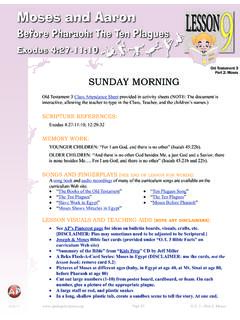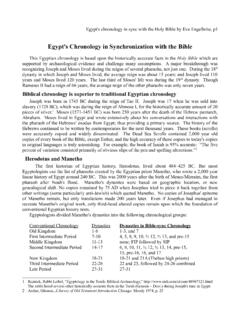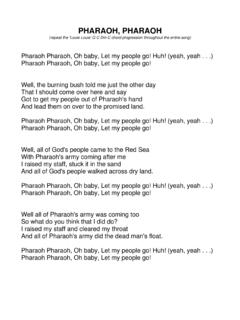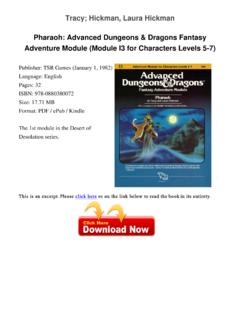Transcription of AMENHOTEP II AND THE HISTORICITY OF THE EXODUS …
1 AMENHOTEP II AND THE HISTORICITY . OF THE EXODUS - pharaoh . BY DOUGLAS PETROVICH. I. INTRODUCTION. Few disciplines related to Biblical inerrancy are scrutinized more intensely than HISTORICITY . Accordingly, questioning the Bible's HISTORICITY is nothing new to Biblical studies, as evidenced by Ladd's remark, It is the author's hope that the reader may be helped to understand that the authority of the Word of God is not dependent upon infallible certainty in all matters of history and criticism. 1 A more extreme recent trend, popular in the study of ancient Israel's storied past, is a revisionistic version of Biblical A prime example is seen in the words of Finkelstein, who speaks of the rise of the true national state in Judah [in the eighth century BC].. That national state produced a historical saga so powerful that it led Biblical historians and archaeologists alike to recreate its mythical past from stones and potsherds.
2 3. Such attacks on the inerrancy of the Bible's HISTORICITY necessitate a reasoned defense of its historical accuracy. As Lindsell writes, When inerrancy is lost, it is palpably easy to drift into a mood in which the HISTORICITY of Scripture along with inerrancy is lost. 4 The danger of compromising the inerrancy of Biblical HISTORICITY became vivid to the present writer when he learned that a transfer student who entered the seminary where he teaches was taught in another theological institution that Biblical inerrancy does not even extend into the realm of history. Such a position is unacceptable, and it must be opposed rigorously. The present work examines the trustworthiness of Biblical history by using the Hebrew EXODUS from Egypt (hereinafter, simply EXODUS ) as a test case. More specifically, an examination of the EXODUS - pharaoh 's life will reveal whether Biblical history can be harmonized and synchronized with Egyptian history, and whether Biblical chronology is clear and trustworthy when relevant passages are interpreted literally.
3 The need for evaluating the former premise is that many Egyptologists are leading the charge to deny the veracity of the EXODUS , attempting to persuade Biblical scholars and the Christian populace at large that the EXODUS never actually occurred. Renowned Egyptologist Donald Redford concludes, The almost insurmountable difficulties in interpreting the EXODUS -narrative as history have led some to dub it mythology rather than .. a detailed reporting of the historical facts' and therefore impossible to locate geographically. 5 Redford then betrays his affinity with this fraternity, stating that despite the lateness and unreliability of the story in EXODUS , no one can deny that the tradition of Israel's coming out of Egypt was one of long standing. 6. The need for evaluating the latter premise is that many Biblical scholars who affirm the HISTORICITY of the EXODUS now date it to the 13th century BC, a step that requires a redefinition of concrete numbers in Biblical passages that, if taken literally, would indisputably place the EXODUS in the 15th century BC.
4 The eminent Egyptologist and Biblical scholar Kenneth Kitchen is foremost among them: Thus, if all factors are given their due weight, a 13th-century EXODUS remains at present the least objectionable dating, on a combination of all the data (Biblical and otherwise) when those data are rightly evaluated and understood in their context. 7 While Kitchen is a vital contributor in the field of OT history and chronology, the accuracy of his conclusion here is disputable, along with whether he has evaluated all of the data correctly. 1. George Ladd, The New Testament and Criticism (Grand Rapids: Eerdmans, 1967), 16. 2. William G. Dever, What did the Biblical Writers Know and When did They Know It? (Grand Rapids: Eerdmans, 2001), 4. 3. Israel Finkelstein, City-States to States, in Symbiosis, Symbolism, and the Power of the Past, ed. William G. Dever and Seymour Gitin (Winona Lake, Ind.: Eisenbrauns, 2003), 81.
5 4. Harold Lindsell, The Battle for the Bible (Grand Rapids: Zondervan, 1976), 206. 5. Donald B. Redford, Egypt, Canaan, and Israel in Ancient Times (Princeton, NJ: Princeton University Press, 1992), 408 409. 6. Ibid., 412. 7. Kenneth A. Kitchen, On the Reliability of the Old Testament (Grand Rapids: Eerdmans, 2003), 310. 1. Wood rejects the theory of a 13th-century-BC EXODUS , originally propagated by Albright, appealing to a reevaluation of the archaeological evidence pertinent to key Palestinian cities in Young also opposes this trend: A date for the EXODUS in the mid-fifteenth century BC has been much maligned because of favorite theories that identified various pharaohs of a later date with the pharaohs of the oppression and EXODUS .. It is hoped that the present study has strengthened the case for the accuracy of the chronological numbers as preserved in the Masoretic text, and at the same time has helped to discredit theories which put the EXODUS anywhere but in the middle of the Fifteenth Century BC.
6 9 Just as Young established a 15th-century date for the EXODUS by chronological means, the present writer seeks to accomplish this goal by historical means, namely by examining the reign of pharaoh AMENHOTEP II (ca. 1455 1418 BC),10 which coincides with that of the EXODUS - pharaoh if adhering to conventional views of Biblical and ancient Egyptian chronology. By answering the following questions, it will be seen whether AMENHOTEP II remains a viable candidate for the EXODUS - pharaoh , and whether Biblical history can be exonerated under the scrutiny of synchronization with Egyptian history. Does AMENHOTEP II qualify as the pharaoh who lived through the tenth plague because he was not his father's eldest son? Could the eldest son of AMENHOTEP II have died during the tenth plague, which must be true of the EXODUS - pharaoh 's son? Did AMENHOTEP II die in the Red Sea, as the Bible allegedly indicates about the EXODUS - pharaoh ?
7 11 Can any of AMENHOTEP II's military campaigns be related to the EXODUS events? Can the loss of over two million Hebrew slaves, certainly Egypt's slave-base at the time, be accounted for in the records of AMENHOTEP II's reign? Is there any evidence to confirm that AMENHOTEP II interacted with the Hebrews after they left Egypt? If AMENHOTEP II is the EXODUS - pharaoh , could the obliteration of Hatshepsut's image from many Egyptian monuments and inscriptions be attributed to backlash from the EXODUS events? II. THREE INTRODUCTORY BACKGROUND MATTERS. 1. The Reason for Moses' Omission of the EXODUS - pharaoh 's Throne-Name. Every time Moses wrote the dynastic title of the EXODUS - pharaoh , it was devoid of the pharaoh 's throne-name ( Sesostris, AMENHOTEP , etc.), which is known in Egyptology as the This, however, was not the practice of later Biblical writers especially writers of the historical books, who routinely transliterated each pharaoh 's praenomen.
8 Beginning with the reign of pharaoh Shishak. For example, Shishak is named in the OT seven times, though never is he referred to merely as pharaoh . 13 The same is true of pharaoh Neco, whose name appears nine The only exception to this rule apart from the 21 references in the prophetic books of Isaiah, Jeremiah, and Ezekiel, where the Egyptian monarch is referred to only as pharaoh is when the Hebrew authors retrospectively write about the EXODUS - pharaoh , always leaving him The question that arises is why Moses consistently omitted the throne-names of pharaohs, especially in the historical book of EXODUS . 8. Bryant G. Wood, The Rise and Fall of the 13th-Century EXODUS -Conquest Theory, JETS 48:3 (Sep 2005), 476. 9. Rodger C. Young, When Did Solomon Die?, JETS 46:4 (Dec 2003), 603. 10. Both here and throughout the present work, any dating that follows the formula, ca. xxxx yyyy BC, signifies the regnal years of a given monarch, unless otherwise noted.
9 The reason for settling on these dates will be discussed subsequently. 11. It is probably more accurate to refer to the Red Sea as the Sea of Reeds, but the traditional designation will be used here for simplicity. For an excellent study on this topic, see Hoffmeier's chap. 9, The Problem of the Re(e)d Sea (James K. Hoffmeier, Israel in Egypt: The Evidence for the Authenticity of the EXODUS Tradition [New York: Oxford University Press, 1996], 199). 12. While any given pharaoh of Egypt's New Kingdom received a throne-name (praenomen) upon his accession either as the sole monarch or as the coregent for a senior pharaoh who wanted a smooth regnal-transition at the time of his imminent death he merely appended this praenomen to his nomen, the birth name that had always been with him. Each name was enclosed in a cartouche. 13. See 1 Kgs 11:40, 14:25; and 2 Chr 12:2, 5 (twice), 7, and 9. The fact that this new trend began during the reign of Shishak (Shoshenq I) should be of no surprise to the student of Biblical history, since Shishak's reign signaled both the beginning of a new ruling dynasty, the 22nd Dynasty of Egypt, and the beginning of foreign rule under pharaohs who hailed from Libya.
10 14. See 2 Kgs 23:29, 33, 34, 35; 2 Chr 35:20, 21, 22; 36:4; and Jer 46:2. pharaoh Hophra is named once as well, though his name appears only in a prophetic writing, where God calls him, pharaoh Hophra, King of Egypt (Jer 44:30). 15. Any temptation to doubt the HISTORICITY of the Biblical text on account of the presence of an unnamed pharaoh should be avoided vigorously, since surely historians would not dismiss the HISTORICITY of Thutmose III's Megiddo campaign because the names of the kings of Kadesh and Megiddo are not recorded in the ancient Egyptian accounts (Hoffmeier, Israel in Egypt, 110). 2. a. Omission of pharaoh 's Throne-Name not Theologically Motivated. The absence of pharaoh 's praenomen in the biblical history of the second millennium BC is often used either to support the assertion of the legendary nature of the EXODUS narrative, or to demonstrate that the Hebrew writers were not truly interested in history.









